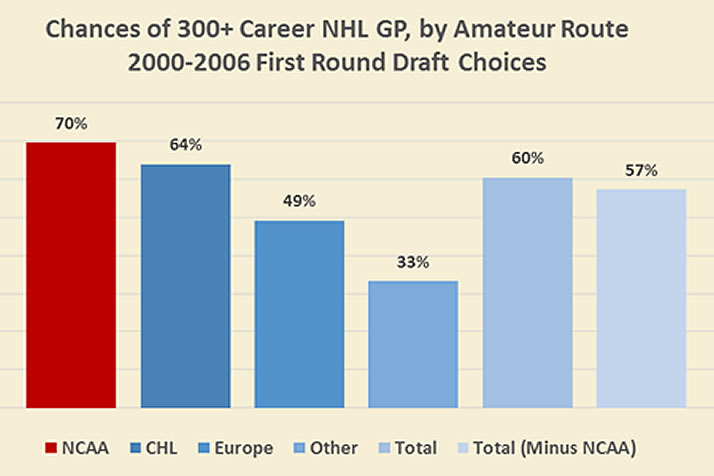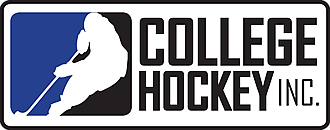Monday, June 23, 2014
Study: NCAA Leads in NHL Draft Success
70% of NCAA first-round picks from 2000-06 made the NHL, outpacing all other development paths.

By Nate Ewell
There will not be 10 current or future NCAA players selected in the first round of the 2014 NHL Draft next week in Philadelphia. We know this from prognosticators’ mock drafts (like this one, or these) and past experience; only once has one-third of the first round been made up of NCAA players, in 2007 (11).
Washington Post: College hockey players undervalued at the NHL Draft and here’s why
The Score: Why you should hope your favorite team drafts an NCAA hockey player
ESPN.com: College players fit well in NHL
Nevertheless, former college hockey players made up 31% of all NHL players in 2013-14. It marked the fourth straight year that number was at 30% and signs suggest that number will continue to grow.
Clearly there’s a disconnect between the NHL Draft – which should forecast the future makeup of the league – and what we end up seeing on the ice. Why is that?
Hits and Misses
Drafts in every sport have their hidden gems, and the NHL is no exception. What seems to be a theme, however, is how many of those late-round stars come from the NCAA ranks.
A popular pastime among hockey news organizations is to look back at drafts five, 10 or 15 years ago and “re-draft” them – see where the selections should have fallen, given how the players’ careers have played out.
Invariably – no matter the year or the news organization – NCAA players were under-represented in the original draft.
|
Source |
Original Draft |
Re-Evaluated |
|
2 NCAA players in 1st Rd. |
5 NCAA players in 1st Rd. |
|
|
9 NCAA players in 1st Rd. |
10 NCAA players in 1st Rd. |
|
|
2 NCAA players in top 11 picks; |
4 NCAA players in top 9 picks; |
|
|
5 NCAA players in top 23 picks |
6 NCAA players in top 23 picks |
|
|
4 NCAA players in 1st Rd. |
6 NCAA players in 1st Rd. |
|
|
0 NCAA players in top 15 picks |
4 NCAA players in top 15 picks |
NCAA hockey’s success in producing late-round or undrafted NHLers isn’t too surprising when looking at the overall player pool. While 31% of all players in the NHL played college hockey, nearly half of all NHL players who were taken in the fifth round or later (or undrafted) developed in college hockey.
High Success Rate
While late-round surprises can change our perspective on previous drafts, the true measure of success for the teams making the selections lies in the performance of its top picks. Good teams draft more hits than misses in the first two rounds.
Not surprisingly, there is a correlation between where a player is drafted and how many games he will play in the NHL. Here’s a look at the seven drafts from 2000-06.
Who Makes It?
Those odds demonstrate the importance of the first round for NHL teams. If you draft a player who doesn’t play 300 career games, chances are 18 of your competitors have an advantage on you – in a league where 16 teams make the playoffs.
So looking deeper at those first-round draft choices, are some picks more likely to “make it” than others? Looking at the different development paths NHL prospects can follow, those on the NCAA route have a 70% chance of playing 300 career NHL games – the best of any development path and a full 10 percentage points better than the average.
Those 46 NCAA picks outperformed the others despite, on average, being taken slightly later in the first round.
| Avg. Draft Position, 2000-06 First Rounders | |
| 61 Europeans | 14.9 |
| 100 CHL | 15.7 |
| 46 NCAA | 16.0 |
Adjusting the definition of “success” produces similar results. Lowering the threshold to 200+ GP (still 100+ for goalies), 73.9% of those NCAA draft picks “make it,” compared to 65.9% of all others.
Likewise, expanding the scope to the first two rounds of the draft produces similar results. The 448 first-and second-round picks from 2000-2006 had a 42% chance of playing 300+ games in the NHL. The 95 NCAA players in that group had the best success rate of any development route at nearly 50% (47 of 95).
NCAA Picks and Team Success
The 1,898 draft picks from 2000 to 2006 included 483 NCAA players. All 30 NHL teams selected a significant number of players on the NCAA route, with some selecting significantly more than the 16.1 average.
Five of the six teams with the most NCAA selections – all with at least 22 in that seven-year span – finished among the top 10 teams in points in 2013-14. What’s more, between Chicago, Los Angeles and Pittsburgh, they account for five of the six Stanley Cup championships won since 2009.
On every one of those top six teams, an NCAA draft pick from 2000 to 2006 remains a key contributor on those teams today, including Conn Smythe Trophy winners Jonathan Toews and Jonathan Quick.
Why is NCAA Successful?
The benefits of each development path are points of debate, but there are structural differences with each that could impact the success rate of its players. Specifically, the NHL’s collective bargaining agreement (CBA) dictates different ways that prospects on each path are handled, while each path’s internal configuration has an impact on player development.
NCAA coaches and other supporters point to those key differences as reasons for the high success rate of NCAA players relative to other avenues.
The NHL CBA gives NCAA players the opportunity to spend four years in school before signing professional contracts – and gives NHL teams the opportunity to monitor their prospects’ progress during that time without losing their rights. While CHL players age out of junior hockey at 20 years old and must be signed by NHL teams or returned to the draft, NHL teams maintain an NCAA players’ rights throughout his time in college – up to age 22, 23 or 24 in most cases.
Nearly half of the 305 former NCAA players in the NHL spent four years in school. Not surprisingly that proportion is smaller for the 59 former first-round draft picks in that group, but 42% still stayed three or four years.
The other significant difference in the NCAA route is the structure of the NCAA season, with teams playing approximately 40 games per year, primarily on the weekends.
NCAA supporters cite this schedule – as opposed to a “pro-style” schedule of 60+ games – as a positive for player development. U.S. college hockey maintains a practice-to-game ratio of at least two-to-one and allows time for strength and conditioning work.
Many of the players included in this study cite the development they enjoyed in college (see this video), while independent experts notice it as well.
“You can see the difference between the college and junior guys,” said Chicago Blackhawks strength and conditioning coach Paul Goodman. “The schedule in college allows you more time in the weight room, so the biggest thing that I notice is that they’re more well-rounded in the room during the workouts. They’re familiar with the technique and they also have a very good base.”
Conclusion
Friday night’s first round of the 2014 NHL Draft will feature 30 selections, and history suggests that around 18 of them will have significant (300+ GP) NHL careers.
Most mock drafts have between three and six of those 30 selections being players headed to NCAA schools in the fall – names like Sonny Milano and Alex Tuch (Boston College), Dylan Larkin (Michigan), Nick Schmaltz (North Dakota) and Jack Dougherty (Wisconsin).
Based on players who have followed the NCAA path before them, those players would seem to have a better chance of enjoying significant NHL careers than the other first-round picks announced Friday night.
